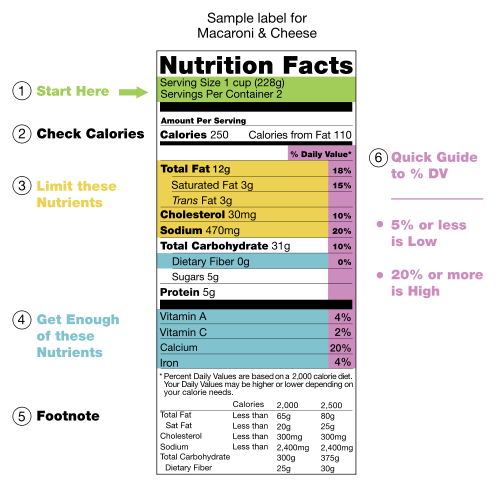Nutrition Labels – Breaking the Code
Nutrition Labels:
Food packaging and labels can be compelling, interesting, and informative, but can also be confusing and deceptive. How do you tell the difference? Here are some tips on reading and understanding nutrition labels, ingredients lists, and food packaging.Nutrition labels are required by the Food and Drug Administration so that people can understand the nutritional value of what they are eating. Nutrition labels have a ton of information, but what does it all mean?
1. Be sure to check the serving size and if the package contains more than one serving. The Nutrition Facts Label information is based on ONE serving, but many packages contain more. Look at the serving size and how many servings you are actually consuming. If you double the servings you eat, you double the calories and nutrients, including the % DVs. When you compare calories and nutrients between brands, check to see if the serving size is the same.
2. Calories count, so pay attention. This is where you’ll find the number of calories per serving and the calories from fat in each serving. Fat-free doesn’t mean calorie-free. Lower fat items may have as many calories as full-fat versions. If the label lists that 1 serving equals 3 cookies and 100 calories, and you eat 6 cookies, you’ve eaten 2 servings, or twice the number of calories and fat.
3. Know your fats and reduce sodium (salt) for your health. Get the most nutrition for your calories—compare the calories to the nutrients you would be getting to make a healthier food choice. Trans fat doesn’t have a % DV, but consume as little as possible because it increases your risk of heart disease. The % DV for total fat includes all different kinds of fats. To help lower blood cholesterol, replace saturated and trans fats with monounsaturated and polyunsaturated fats found in fish, nuts, and liquid vegetable oils. Limit sodium to help reduce your risk of high blood pressure.
4. Look for foods that are rich in these nutrients. Use the label not only to limit fat and sodium, but also to increase nutrients that promote good health and may protect you from disease. Some Americans don’t get enough vitamins A and C, potassium, calcium, and iron, so choose foods with the higher % DV for these nutrients. Get the most nutrition for your calories—compare the calories to the nutrients you would be getting to make a healthier food choice.
5. You can use the % DV to make dietary trade-offs with other foods throughout the day. The * is a reminder that the % DV is based on a 2,000-calorie diet. You may need more or less, but the % DV is still a helpful gauge.
6. The % DV is a general guide. It can to help you link nutrients in a serving of food to their contribution to your total daily diet. It can help you determine if a food is high or low in a nutrient—5% or less is low, 20% or more is high.
Carbohydrates: Fiber and sugars are types of carbohydrates. Healthy sources, like fruits, vegetables, beans, and whole grains, can reduce the risk of heart disease and improve digestive functioning. Whole grain foods can’t always be identified by color or name, such as multi-grain or wheat. Look for the “whole” grain listed first in the ingredient list, such as whole wheat, brown rice, or whole oats. There isn’t a % DV for sugar, but you can compare the sugar content in grams among products. Limit foods with added sugars (sucrose, glucose, fructose, corn or maple syrup), which add calories but not other nutrients, such as vitamins and minerals. Make sure that added sugars are not one of the first few items in the ingredients list.
Protein: Most Americans get plenty of protein, but not always from the healthiest sources. When choosing a food for its protein content, such as meat, poultry, dry beans, milk and milk products, make choices that are lean, low-fat, or fat free to reduce total calories while getting your protein.
The key is actually reading the ingredients list so you can know for sure what’s in the food. Look for foods that have as short a list as possible, have ingredients that you know what they are, or is a fresh food that doesn’t have any added ingredients.
Choosing whole foods can go a long way to promoting health and maintaining a healthy weight and avoiding lifestyle related conditions. The less processed and natural foods are, generally, the better they are for us to eat. Make nutrition and whole foods a foundation to your wellness routine.
Browse our Merchant Directory to include the assistance of a Nutrition expert, Personal Trainer, Holistic Health Services, Lifestyle Coach, or to find Healthy Food options.
Sources: Michael Pollan In Defense of Food, FDA.gov
Author: Tony Montijo, BS Kinesiology, CPT, CES







